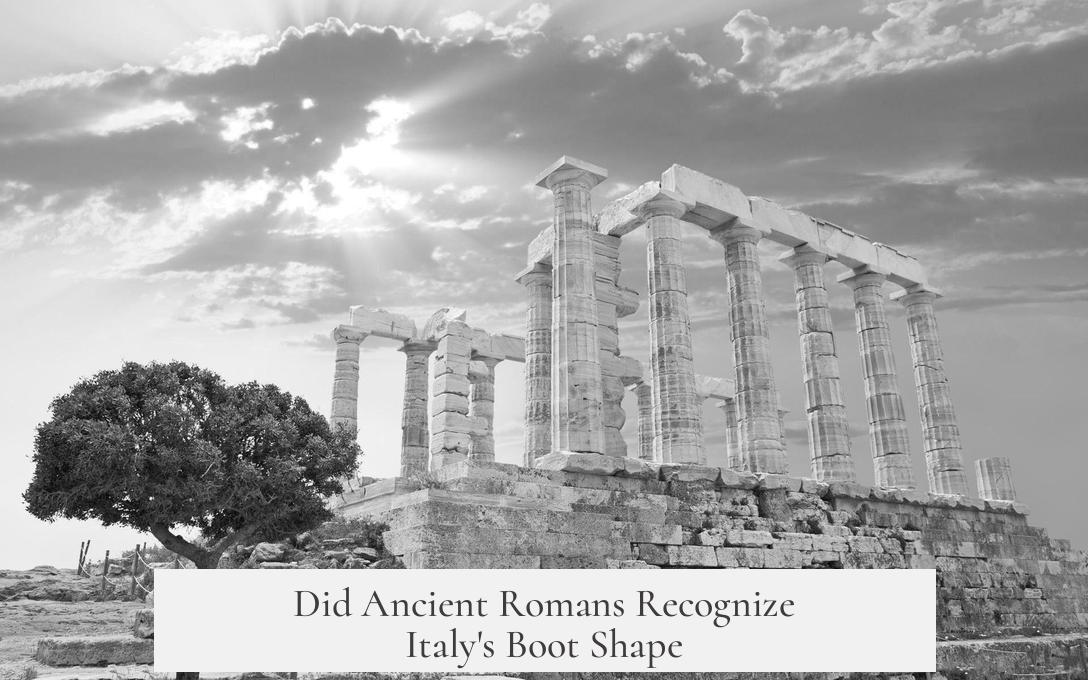The Ancient Romans were aware of Italy’s general outline, but there is no solid evidence they described or thought of the peninsula as shaped like a boot. They knew the Italian peninsula’s shape in rough terms, thanks to Greek maps and their own geographical knowledge, but the specific “boot” metaphor appears to be a later development.
Ancient Greek cartographers, such as Anaximander and Hecataeus around 500 B.C., created some of the earliest maps featuring the Mediterranean region. Their maps showed recognizable landmasses including the Italian peninsula. The Greeks’ understanding of the Mediterranean, known as the “center of the Earth” to them, was surprisingly detailed for the time. Since the Romans inherited much of their geographic knowledge from the Greeks, it stands to reason they were also aware of Italy’s distinctive shape.
However, mapping in antiquity was not precise. Surveys and cartography were limited by technology and understanding of geography. Maps from the Middle Ages, such as the Hereford Mappa Mundi, show Europe with considerable distortion. Renaissance advances improved accuracy, but ancient and medieval maps often exaggerated landmasses or presented them symbolically rather than realistically. So while the basic outline of Italy was known, it may not have been viewed with the exact detail modern observers see.
Regarding the boot metaphor, there is no record from Roman literature or artifacts indicating the Romans themselves made this comparison. Ancient Romans wore footwear called caligae, military boots that were openwork and flat-soled, unlike the modern idea of a boot with a high heel. These boots were practical, designed for marching soldiers and cavalry, often studded for traction but lacking external heels or the distinctive knee-high high-heeled style associated with later boots.
The term “boot” as a shape descriptor relies on knowing footwear styles beyond what the Romans commonly used. The Romans did not have high-heeled, calf- or knee-high boots with external heels. Their boots had internal heel padding, similar to modern athletic shoes, which makes a direct visual analogy unlikely. No classical sources refer to Italy’s shape as analogous to their footwear.
Spurs and cavalry equipment complicate the image slightly. The earliest use of spurs dates to the Celtic La Tène culture in the 5th century B.C., and the Romans adopted bronze and iron spurs during their empire. Spurs were simple hooks, used by fighting cavalry and not commonly depicted in Roman, Byzantine, or Greek art. While spurs became symbols of rank later on, this association doesn’t translate into a metaphor for Italy’s shape as a boot.
Some historic maps or later descriptions liken Italy to a boot, but these references are from centuries after the Roman era, often from the medieval period onward. This metaphor likely emerged when cultural familiarity with high-heeled boots or riding boots became more common, perhaps influenced by geographic simplifications in art and education. The precise timing of the boot metaphor’s origin remains unclear, but it seems post-Roman rather than ancient Roman in origin.
Ancient Romans did know Italy as “Italia,” a name that remains today. This name, however, does not imply a shape analogy nor does it refer to boots or footwear. Instead, it functioned as the political and geographic term for the peninsula. Roman knowledge of Italy focused on its regions, tribes, and administrative divisions instead of abstract shape-based nicknames.
In summary:
- The Ancient Romans understood the Italian peninsula’s overall shape.
- No known ancient Roman texts or artifacts describe Italy as a boot.
- Ancient Roman footwear (caligae) differed from modern boots; they had no external heels or styles matching the boot metaphor.
- The boot comparison likely arose much later, in medieval or Renaissance periods.
- The name “Italia” was geographic and political, with no metaphorical link to footwear.
This assessment respects the absence of direct evidence and highlights the likely evolution of the boot analogy in European culture long after the fall of the Western Roman Empire.
Key takeaways:
- Romans knew Italy’s rough outline but did not specifically liken it to a boot.
- Ancient Roman shoes (caligae) differ greatly from modern boots, limiting metaphor use.
- Greek maps influenced Roman geographic understanding but were symbolic, not precise.
- The boot shape analogy originated after Roman times, likely during the medieval or Renaissance era.
- “Italia” remained a formal geographic term without shape-based nicknames in antiquity.
Did the Ancient Romans recognize Italy’s shape as resembling a boot?
Ancient Romans knew Italy’s general outline well. Maps from the period suggest they saw the peninsula’s form. However, there is no clear evidence they described it as a boot.
Why didn’t the Romans call Italy a “boot” despite its shape?
The Romans wore flat-soled, openwork boots called caligae. They lacked high-heeled, knee-high boots that would fit the modern “boot” image. This footwear limited the metaphor’s use in Roman times.
Are there records of Romans comparing Italy’s shape to any footwear?
No ancient texts or names appear linking Italy’s shape to shoes or boots. The boot comparison seems to arise in later historical periods, not the Roman era.
Did Roman soldiers’ footwear influence how they might see Italy’s shape?
Roman soldiers wore hobnailed boots called caligae. These were flatter and more practical than the high-heeled boots seen later. Thus, their footwear did not inspire a boot metaphor for Italy.
When did the idea of Italy as a boot likely develop?
This image probably emerged after the Roman Empire’s decline, gaining popularity in medieval or Renaissance maps. Romans knew the shape but likely didn’t make the boot comparison themselves.




